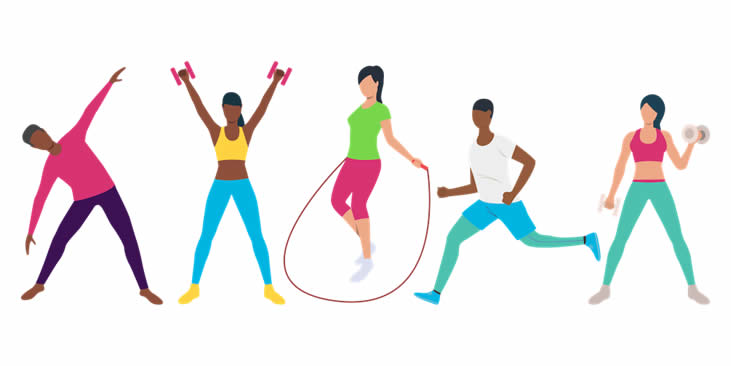by: Dr. Nick Ricca, DPT
Introduction: In today’s fast-paced world, maintaining good health and managing stress are top priorities. One powerful tool that can help us achieve these goals is exercise. Regular physical activity has a multitude of benefits, ranging from preventing chronic diseases to enhancing longevity and reducing stress. In this blog, we will explore how exercise can contribute to disease prevention, promote a longer and healthier life and act as a natural stress reliever. Let’s start with a review of the American Heart Association’s recommendations:
Current Exercise Prescription Guidelines according to American Heart Association:
- Get at least 150-200 minutes per week of moderate-intensity aerobic activity, this would constitute zone 2 cardio that can be completed through nasal breathing or 75 minutes per week of vigorous aerobic activity, or a combination of both, preferably spread throughout the week.
- Add moderate or greater intensity muscle-strengthening activity (such as resistance or weights) that involve all major muscle groups on at least 2 days per week.
- Spend less time sitting. Even light-intensity activity can offset some of the risks of being sedentary.
- Gain even more benefits by being active at least 300 minutes (5 hours) per week.
- Increase amount and intensity gradually over time
- Balance Training: Older adults aged 65 and above, or those at risk of falls should include balance training into routine with activities such as Tai-Chi, standing on one leg, heel toe-walking, etc. Incorporate balance exercises at least 3x a week.
Remember, these guidelines are general recommendations and may vary depending on an individual’s health status, fitness level, and specific goals. It’s important to consult with a healthcare professional for personalized advice and recommendations tailored to your needs.
Section 1: Disease Prevention through Exercise:
Regular exercise plays a crucial role in reducing the risk of developing various chronic diseases. One area where exercise has a significant impact is cardiovascular health. Aerobic exercises, such as brisk walking, cycling, and swimming, strengthen the heart, improve circulation, and lower the risk of heart disease, high blood pressure, and stroke. Additionally, physical activity helps maintain healthy cholesterol levels, regulates blood sugar, and reduces the risk of type 2 Diabetes.
Exercise has also been linked to a reduced risk of certain types of cancer, including colon, breast, lung, and endometrial cancers. It may help lower cancer risk by helping to maintain a healthy body weight, enhancing immune function, and reducing inflammation. Furthermore, weight-bearing exercises, such as walking or strength training, increase bone density, reducing the risk of osteoporosis and fractures, particularly in postmenopausal women.
Section 2: Enhancing Longevity through Exercise: Engaging in regular exercise has consistently been associated with increased longevity and a higher quality of life. Exercise contributes to longevity by improving cardiovascular function, enhancing metabolic health, and reducing inflammation.
√ Aerobic exercise strengthens the heart, improves circulation, and lowers the risk of cardiovascular diseases, which are leading causes of mortality.
√ Regular physical activity helps maintain a healthy weight, regulates blood sugar levels, and improves lipid profiles, all of which contribute to overall metabolic health. By reducing chronic inflammation in the body, exercise also plays a role in preventing various age-related diseases.
√ Exercise helps preserve muscle mass, bone density, flexibility, and balance as we age. This can reduce the risk of falls, fractures, and loss of independence, contributing to a longer and healthier lifespan.
By incorporating exercise into our lives, we can maintain current functional abilities and enjoy an active lifestyle into old age.
Section 3: Reducing Stress through Exercise: It’s no secret that we all encounter life stressors, finding effective ways to manage those stressors is crucial to our well-being.
Exercise is a powerful stress management tool that provides both physical and mental benefits. When we engage in physical activity, our bodies release endorphins, natural chemicals in the brain that promote feelings of happiness and well-being. These endorphins act as natural stress relievers, helping us cope with daily challenges.
Conclusion: Ready to take control of your exercise goals and overall well-being? Make physical therapy your partner on this journey. With their expertise, guidance, and personalized approach, physical therapists can help you prevent diseases, enhance longevity, and reduce stress through targeted exercise programs and interventions. Take the first step toward a healthier, happier you by consulting with one of our expert physical therapists today. Together, you can develop a plan tailored to your needs and goals, ensuring that you achieve optimal results and enjoy the benefits of a well-rounded exercise routine. Don’t wait—start your physical therapy journey now and unlock your full potential for a healthier and more fulfilling life.
Schedule an appointment with a physical therapist today and unlock your potential in reaching your exercise goals and optimizing your overall health. Your future self will thank you.
Call 352-873-3058 and schedule an Apt. with Strive Physical Therapy today.





